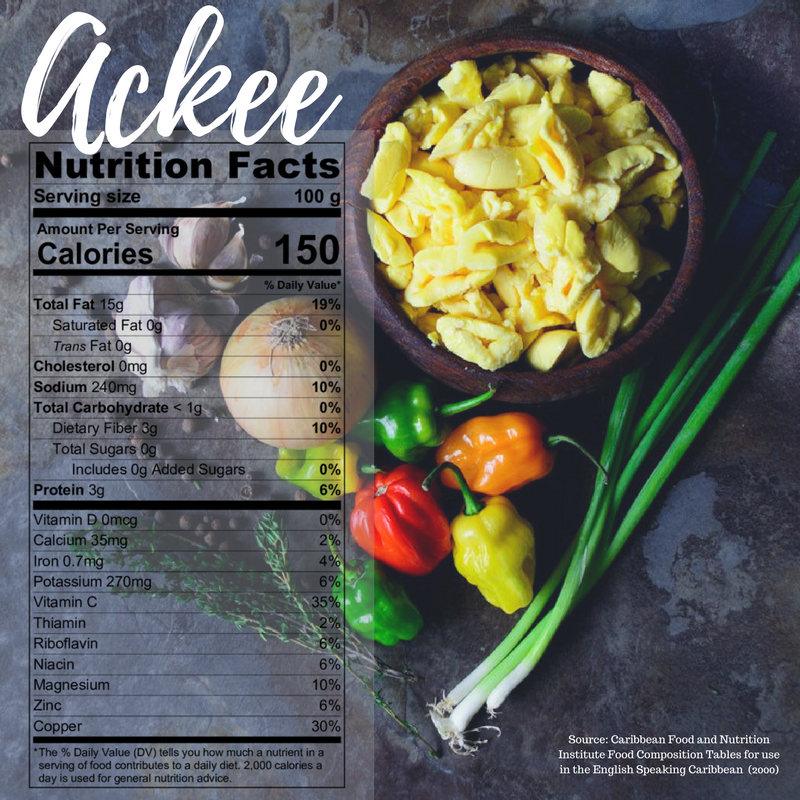The question that usually follows “what is ackee?” is “Is ackee good for you?”
Now though this website isn’t devoted to “healthy” ackee recipes nor do I seek to provide medical or “health” information, I thought it would be nice to have a reference point. (It’s always best to do ones own research 😉) So let’s take a look and see what the nutritional make up of ackee is. I made this nutritional label with the information contained in the Caribbean Food and Nutrition Institute’s (CFNI) Food Composition Tables for use in the English Speaking Caribbean published in 2000.
The values used are the ones noted in the supplement for canned and drained ackee. Since ackee is typically parboiled before being cooked in another dish, even if you are starting with fresh ackee and boiling it yourself the data should be close enough. The sodium could be less since you would be able to control that factor whereas the canned type is packaged in brine, thus the extra salt there.
Ackee Nutrition Facts
100g of ackee fills a little more than half cup; and this serving size has approximately 150 calories; 15g of fat; 3g of protein and less than 1g of carbohydrates. This versatile high fat fruit therefore, could be suitable for persons who follow a ketogenic or other high fat diet.

From the CFNI’s tables I noted that ackees provided a significant amount of our daily copper requirement. This made me curious as to what copper does. I learned that along with iron it helps the body to form red blood cells and keeps our blood vessels, nerves, immune system and bones healthy and also aids in iron absorption. That’s pretty cool!
Nutritional reports on ackee usually state that they are rich in potassium, magnesium, calcium and sodium but low in phosphorus and zinc. Some studies show that the high oil content of ackee arils can be compared to that of peanuts, rapeseed and sunflower seeds and higher than that of soybeans.
The ripe arils contain all essential amino acids and they have been found to be rich in linoleic, oleic, palmitic and stearic fatty acids all of which are known to help reduce the risk of coronary heart diseases when included in a well balanced diet [1].
Of the fatty acids previously mentioned linoleic acid (a polyunsaturated omega-6 fatty acid) is the foremost. It is which is an essential fatty acid, meaning the body doesn’t make it and we must obtain it from our diets. Omega-6s are important for membrane development in the eye and brain.
This is just a tip of the iceberg as you can imagine. It is not meant to be an in depth nutritional analysis of the ackee fruit.
If you are interested in more ackee information, see the sources cited below. Or visit the website of the Department of Chemistry, UWI Mona; they have conducted ackee research since the 1950s including identifying the toxic natural chemicals contained in ackee and how they change with maturity and cooking. Toxicity is discussed here: Ackee Concerns.
How many carbs are in ackee?
05/17/19 (Update) – I’m adding a question and answer here about the varying amount of carbs in ackee.
Question:
Those nutrion numbers are not what it says on my tin.. It says the carbohydrate values are about 30g per 100g.
Am I buying a different type? Or are there just a lot of additives in the tinned kind.
Answer:
Thanks for your question.
This discrepancy is one that I’ve researched. Unfortunately, I have not been able to get a satisfactory answer. All packaged food must meet certain labelling requirements and the nutrition information is one of them. I am not certain however, of any measure in place to ensure the accuracy of the nutrition information provided.
I’ve bought several different brands of ackee and notice that for the same 100g portion the macronutrient breakdown is different. 30g of carbs is insane, do you mind telling me what brand that was? I’ve seen as high as 11g. For there to be that much carbs they would have to be sugar in the brine and I doubt that’s the case. I reached out to chemists at the University of the West Indies, Mona since they have led the charge on ackee research since the 1950s. In the first instance they suggested that maybe it was a difference in serving size. That I know isn’t the case since they all note 100g as a serving.
Below is a screenshot from the Caribbean Food and Nutrition Institute tables for the English speaking caribbean. As you can see there is a difference in the carbs in fresh ackee and canned ackee but definitely not 30g of carbs!

So I reached out again to the chemists showing this same screenshot. One suggested: “It may be possible that some of the water soluble carbohydrates get leached from the ackee during the blanching which is performed prior to canning”
Subsequent to that I found another study investigating the difference in ackee when they are:Allowed to open on the tree and then harvested, against those that were rack dried for 1, 2 and 3 days.
There were slight variations in the moisture content, fat and carbs for each which supports the chemists assertion that there may be leaching of macronutrients in the canning process.
For all my recipes therefore (and in the ackee nutrition article on my site), I use the information in the table above for canned ackee.
[1] Dossou, Veronica M., et al. “Physicochemical and Functional Properties of Full Fat and Defatted Ackee (Blighia sapida) Aril Flours.” American Journal of Food Science and Technology 2.6 (2014): 187-191.
[2] Mitchell, Sylvia & Webster, SA & Ahmad, MH. (2008). Ackee (Blighia sapida) – Jamaica’s top fruit. Jamaica Journal. 31. 84-89.
The direct links to the PDF formats of the papers cited above are here and here respectively.
